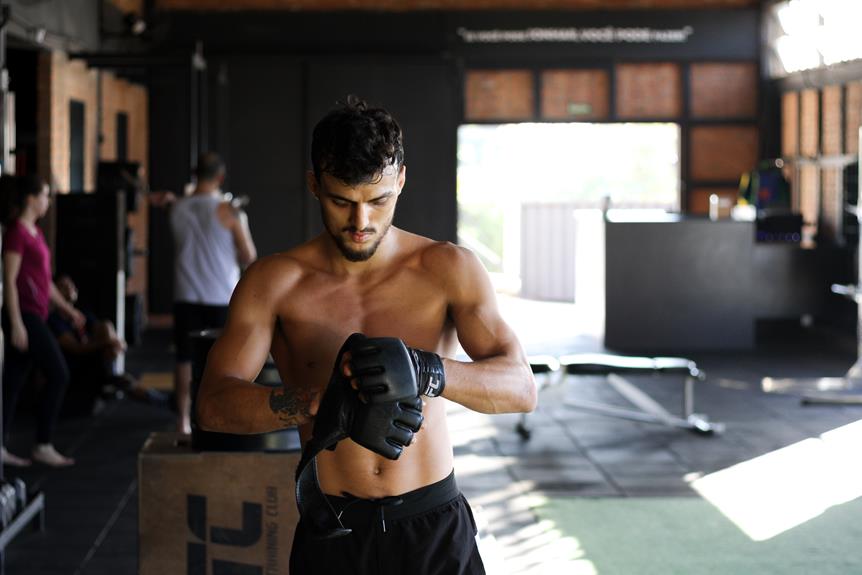Contrary to the adrenaline-fueled excitement that captivates fans, the question of whether anyone has perished in the brutal realm of professional mixed martial arts persists.
In the world of UFC and MMA, where skill and strength collide, the safety of its warriors is paramount. This article delves into the updated account of fatalities, examining causes, preventability, and the responsibilities of fighters and governing bodies.
With an analytical and impassioned approach, it explores the measures undertaken to preserve the well-being of these modern-day gladiators.
Key Takeaways
- Deaths occur in both sanctioned and unsanctioned MMA events, highlighting the inherent risks in the sport.
- The UFC, the leading MMA organization, has not experienced any deaths since its inception in 1993, which emphasizes their commitment to fighter safety.
- Stricter regulations, improved medical protocols, and better testing can help prevent MMA deaths.
- Weight cutting remains a significant risk factor for fatalities in the sport, and stricter regulations and monitoring are needed to address this issue.
Causes of MMA Deaths
There have been several causes of MMA deaths, including stroke, brain swelling, cardiopulmonary failure, hypertensive heart disease, rhabdomyolysis, kidney failure, and subdural hemorrhage. These fatalities highlight the inherent risks involved in the sport and the need for improved medical protocols and risk management.
Risk factors such as cutting weight have been identified as contributors to some of these causes, emphasizing the importance of stricter regulations and monitoring in preventing deaths. Additionally, the lack of regulation and testing in unsanctioned events has been a significant factor in the preventability of some deaths.
Pre-fight medicals could play a crucial role in identifying underlying health conditions that may lead to fatalities. Ultimately, the responsibility lies with both the fighters and the governing bodies to prioritize safety and implement measures that can help prevent these tragic incidents.
Sanctioned MMA Deaths
Sanctioned MMA deaths have highlighted the need for improved medical protocols and risk management in the sport, particularly in addressing the inherent risks and preventability of fatalities. The impact of regulations on MMA safety cannot be overstated, as they play a crucial role in ensuring fighter safety and minimizing the occurrence of tragic incidents. To further understand the significance of these regulations, let's take a look at some examples of sanctioned MMA deaths:
| Fighter | Location | Cause of Death |
|---|---|---|
| Sam Vasquez | Houston, Texas, USA | Subdural hemorrhage |
| Michael Kirkham | Aiken, South Carolina, USA | Subarachnoid hemorrhage |
| Tyrone Mims | Mount Pleasant, South Carolina, USA | Unknown |
| Leandro Souza | Rio de Janeiro, Brazil | Stroke |
| Booto Guylain | Johannesburg, South Africa | Brain swelling |
These tragic incidents emphasize the importance of implementing regulations that prioritize fighter safety and mitigate the risks involved in MMA. By establishing stricter protocols, enhancing medical care, and conducting thorough pre-fight medical examinations, the likelihood of preventable deaths can be significantly reduced. The responsibility lies with the governing bodies to ensure the well-being of fighters and minimize the occurrence of such tragic events.
Unsanctioned MMA Deaths
Unsanctioned MMA deaths further emphasize the need for improved regulation and safety measures in the sport. The lack of regulation in these underground events poses significant risks to fighters. One major concern is the absence of proper testing and medical attention, which can have dire consequences in case of injuries or health emergencies.
Additionally, weight cutting, a practice commonly employed by fighters to meet weight requirements, poses serious risks to their health. Deaths caused by cutting weight could have been prevented through stricter regulations and monitoring.
Both the fighters and the governing bodies hold responsibility in ensuring the safety of participants in unsanctioned events. It's crucial for the MMA community to address these issues and prioritize the implementation of comprehensive safety measures to prevent avoidable deaths.
Preventability of MMA Deaths
Improved regulation and safety measures are essential in addressing the preventability of MMA deaths. Stricter weight cutting regulations and the importance of pre-fight medicals are crucial factors in mitigating the risks associated with the sport.
Deaths caused by cutting weight could have been prevented through stricter regulations and monitoring. Weight cutting remains a significant risk factor for fatalities in MMA, as it can lead to conditions such as stroke, brain swelling, cardiopulmonary failure, and kidney failure. Implementing more stringent weight cutting regulations, such as monitoring hydration levels and enforcing weight class limits, can help prevent these tragic outcomes.
Additionally, pre-fight medicals play a vital role in identifying underlying health conditions that could lead to complications during a fight. By ensuring thorough and comprehensive pre-fight medical examinations, potential risks can be identified and addressed, further enhancing fighter safety.
It's the responsibility of the governing bodies and commissions to prioritize safety and implement these measures to prevent avoidable deaths in MMA.
The Bottom Line on MMA Deaths
Deaths in MMA and UFC, both sanctioned and unsanctioned, underscore the inherent risks associated with the sport, necessitating a continued focus on fighter safety and the implementation of stricter regulations and protocols. The impact of MMA deaths on the sport can't be ignored, as they've significant implications for public perception of MMA safety.
The following points highlight the bottom line on MMA deaths:
- Deaths occur in both sanctioned and unsanctioned events, emphasizing the inherent risks in the sport.
- The UFC, despite being the largest MMA promotion, hasn't experienced any deaths since its inception in 1993, reflecting their commitment to fighter safety.
- Stricter regulations, improved medical protocols, and better testing can help prevent MMA deaths.
- Weight cutting remains a significant risk factor for fatalities in the sport, necessitating stricter regulations and monitoring.
- The responsibility lies with both the fighters and the governing bodies to prioritize safety and prevent avoidable deaths.
It is imperative for the MMA community to address these issues and take necessary measures to ensure the safety of fighters and maintain public confidence in the sport.
Commission Responsibility
The commission's responsibility in ensuring fighter safety and preventing fatalities in sanctioned events is crucial. Commission oversight plays a pivotal role in implementing and enforcing fighter safety measures to minimize the risks associated with mixed martial arts (MMA) competitions. This responsibility involves setting and enforcing rules and regulations, conducting thorough pre-fight medical examinations, and ensuring that proper medical personnel are present at all events.
Commission oversight extends beyond the actual fights themselves. It includes monitoring the weight-cutting process, which is a significant risk factor for fatalities in the sport. Stricter regulations and monitoring can help prevent deaths caused by the dangerous practice of cutting weight.
Furthermore, the commission's responsibility also involves continuous evaluation and improvement of medical protocols. By staying informed about the latest medical advancements and conducting regular reviews, commissions can implement effective measures to detect and address any underlying health conditions that may put fighters at risk.
Frequently Asked Questions
What Are the Long-Term Effects of Weight Cutting in MMA Fighters?
Long-term effects of weight cutting in MMA fighters include dehydration effects, such as impaired kidney function and increased risk of kidney failure. These can have serious health consequences and require stricter regulations and monitoring to ensure fighter safety.
Are There Any Specific Regulations in Place to Address Weight Cutting in Mma?
Weight cutting in MMA poses significant risks to fighters. While there are regulations in place, such as weight management guidelines, more stringent measures are needed to address the dangers associated with extreme weight cutting and ensure fighter safety.
How Often Are Pre-Fight Medicals Conducted for MMA Fighters?
Pre-fight medicals for MMA fighters vary depending on the jurisdiction, but they are typically conducted before every fight to assess the fighters' health and identify any underlying conditions. Weight cutting can have detrimental effects on fighters' health, making proper medical screenings crucial.
Has the UFC Implemented Any Specific Measures to Improve Fighter Safety?
The UFC has implemented various fighter safety measures and regulations to improve the overall safety of its athletes. These measures include stricter weight cutting regulations, improved medical protocols, and regular pre-fight medicals.
Are There Any Ongoing Efforts to Regulate and Address the Issue of Unsanctioned MMA Events?
Regulating unsanctioned events and implementing fighter safety measures are ongoing efforts in the MMA community. Stricter regulations, improved medical protocols, and better testing are being advocated to prevent avoidable deaths and ensure the well-being of fighters.
Conclusion
In conclusion, the world of MMA hasn't been immune to tragedy, with both sanctioned and unsanctioned deaths occurring within the sport. While the causes of these fatalities vary, it's evident that prioritizing safety and implementing preventive measures is paramount.
The responsibility falls on both fighters and governing bodies to ensure the well-being of MMA athletes. As the sport continues to evolve and measures are taken to mitigate risks, the ultimate goal remains to protect the fighters and create an environment where their passion can thrive without compromising their lives.
- 15 Best Martial Arts Weapons (Fighting & Training) - October 14, 2024
- Is Fencing a Martial Art? (Yes, 4 Reasons Why) - October 14, 2024
- 7 Best Martial Arts for Self-defense Ranked (Highly Effective) - October 14, 2024










